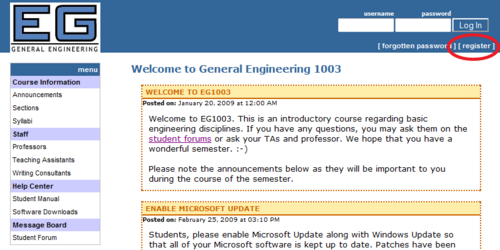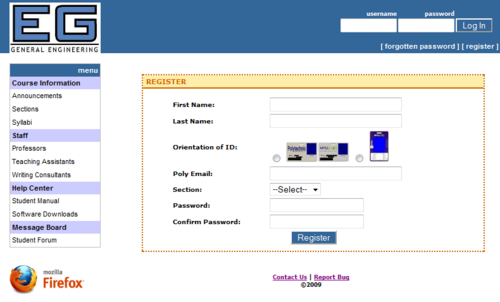Difference between revisions of "Introduction to Microsoft Office"
(2015-08-24 Jack Bringardner) |
|||
| Line 1: | Line 1: | ||
'''<span style="color: red;">Important:</span> Please note that you ''must'' register on the [http://eg.poly.edu EG Website] before performing the lab.''' | '''<span style="color: red;">Important:</span> Please note that you ''must'' register on the [http://eg.poly.edu EG Website] before performing the lab.''' | ||
| Line 13: | Line 11: | ||
= Objectives = | = Objectives = | ||
The objective of this lab is to | The objective of this lab is to master the basics of Microsoft Excel, PowerPoint, and Word and become accustomed with the tasks for which each application is best suited. The goal is to create templates you will use for EG 1003 with these applications. | ||
= Overview = | = Overview = | ||
This lab is designed to | This lab is designed to teach the skills needed to become proficient with the three primary Microsoft applications: Excel, PowerPoint, and Word. These programs are widely used throughout academia and business so familiarity is not uncommon. Completing assignments in EG1003 will require a basic competency in them; the following exercises are designed to ensure you are capable of teaching yourself these fundamentals. | ||
== Microsoft Office == | == Microsoft Office == | ||
Microsoft Office is a software suite that bundles Microsoft Excel, PowerPoint, Word, and more. | |||
Microsoft Excel is a spreadsheet program. Its function is collecting, manipulating, and analyzing data. Microsoft Excel has many features that streamline data analysis. You can use it to generate tables, charts, and graphs. Excel is used for general data manipulation and analysis. It is useful for uncovering the relationships between data sets and identifying trends. Graphs will be required for many lab reports and presentations. | |||
Microsoft PowerPoint is a presentation program; its function is to create slides for presentations. In this course, you will be creating and giving presentations on your lab work and semester-long design project. | |||
Microsoft Word is a document preparation program. Its function is writing and editing text. In this course, you will use Microsoft Word to write lab reports. | |||
= Materials and Equipment = | = Materials and Equipment = | ||
| Line 36: | Line 32: | ||
For students who need an in-depth look at Microsoft Office, see the [[Microsoft Office Skill Builder]]. | For students who need an in-depth look at Microsoft Office, see the [[Microsoft Office Skill Builder]]. | ||
In each of the following exercises: | |||
* Change all generic (highlighted in yellow) text to your own information. | |||
* Copy and paste Excel tables and figures as a picture; screenshots are not acceptable in this class. | |||
* Label tables and figures. | |||
* Use Insert Equation in Word and PowerPoint. | |||
== Microsoft Excel == | == Microsoft Excel == | ||
| Line 48: | Line 47: | ||
<math>K = {^\circ C} + 273.15\,</math> | <math>K = {^\circ C} + 273.15\,</math> | ||
<math> | <math>PV = nRT\,</math> | ||
== Microsoft PowerPoint == | == Microsoft PowerPoint == | ||
Recreate the [[Media:Presentation Template.pdf|Lab Presentation Template]] for lab presentations to given throughout the semester. | Recreate the [[Media:Presentation Template.pdf|Lab Presentation Template]] for lab presentations to be given throughout the semester. | ||
=== Printing Instructions for Recitation === | === Printing Instructions for Recitation === | ||
| Line 58: | Line 57: | ||
* Portrait Orientation | * Portrait Orientation | ||
* Pure Black and White or Grayscale | * Pure Black and White or Grayscale | ||
== Microsoft Word == | |||
Recreate the [[Media:Report Template.pdf|Lab Report Template]] for lab reports to be written throughout the semester. | |||
b. Copy and paste Excel tables and figures as a picture (Copying and pasting as a picture means you select the chart or table in Excel and copy like normal, then when in Word or PowerPoint you select Paste Special > Paste as image. I think we should even add a comment that screenshots are never acceptable in this class. This makes them use Excel formatting so they edit the appearance once, and their reports and presentations remain consistent. If data changes, they go back to the Excel, then recopy and paste as a picture. It also looks much more professional, and allows for better formatting/resizing the image in line with text in Word and PowerPoint without skewing column widths or heights. ) | |||
c. Label tables above and figures below | |||
d. Use insert equation in Word and PowerPoint | |||
== Saving Work == | == Saving Work == | ||
Revision as of 06:10, 2 September 2015
Important: Please note that you must register on the EG Website before performing the lab.
- Click on the register link as shown in Figure 1.
- Fill in the appropriate information on the form shown in Figure 2 and submit it.
- Note: Please make sure that you capitalize the first letter of your first and last name.
- Fill in the remaining information accordingly.
- Note: If your email is fml999@nyu.edu, then fml999 will be your username.
- IMPORTANT!!: After you are registered, a TA must approve your account before you can log in.
Objectives
The objective of this lab is to master the basics of Microsoft Excel, PowerPoint, and Word and become accustomed with the tasks for which each application is best suited. The goal is to create templates you will use for EG 1003 with these applications.
Overview
This lab is designed to teach the skills needed to become proficient with the three primary Microsoft applications: Excel, PowerPoint, and Word. These programs are widely used throughout academia and business so familiarity is not uncommon. Completing assignments in EG1003 will require a basic competency in them; the following exercises are designed to ensure you are capable of teaching yourself these fundamentals.
Microsoft Office
Microsoft Office is a software suite that bundles Microsoft Excel, PowerPoint, Word, and more.
Microsoft Excel is a spreadsheet program. Its function is collecting, manipulating, and analyzing data. Microsoft Excel has many features that streamline data analysis. You can use it to generate tables, charts, and graphs. Excel is used for general data manipulation and analysis. It is useful for uncovering the relationships between data sets and identifying trends. Graphs will be required for many lab reports and presentations.
Microsoft PowerPoint is a presentation program; its function is to create slides for presentations. In this course, you will be creating and giving presentations on your lab work and semester-long design project.
Microsoft Word is a document preparation program. Its function is writing and editing text. In this course, you will use Microsoft Word to write lab reports.
Materials and Equipment
- Lab PC
- Microsoft Office suite
Procedure
For students who need an in-depth look at Microsoft Office, see the Microsoft Office Skill Builder.
In each of the following exercises:
- Change all generic (highlighted in yellow) text to your own information.
- Copy and paste Excel tables and figures as a picture; screenshots are not acceptable in this class.
- Label tables and figures.
- Use Insert Equation in Word and PowerPoint.
Microsoft Excel
Recreate Microsoft Excel Template to illustrate Charles' Law based on the given template.
Use the following formulas to fill the spreadsheet:
Microsoft PowerPoint
Recreate the Lab Presentation Template for lab presentations to be given throughout the semester.
Printing Instructions for Recitation
When printing handouts for recitation, select the following options in the print dialog:
- Handouts, 6 Slides Horizontal
- Portrait Orientation
- Pure Black and White or Grayscale
Microsoft Word
Recreate the Lab Report Template for lab reports to be written throughout the semester.
b. Copy and paste Excel tables and figures as a picture (Copying and pasting as a picture means you select the chart or table in Excel and copy like normal, then when in Word or PowerPoint you select Paste Special > Paste as image. I think we should even add a comment that screenshots are never acceptable in this class. This makes them use Excel formatting so they edit the appearance once, and their reports and presentations remain consistent. If data changes, they go back to the Excel, then recopy and paste as a picture. It also looks much more professional, and allows for better formatting/resizing the image in line with text in Word and PowerPoint without skewing column widths or heights. ) c. Label tables above and figures below d. Use insert equation in Word and PowerPoint
Saving Work
The information on the Lab PCs cannot be accessed outside of the lab rooms. Email copies of all the files you created to your personal account.
| ||||||||




